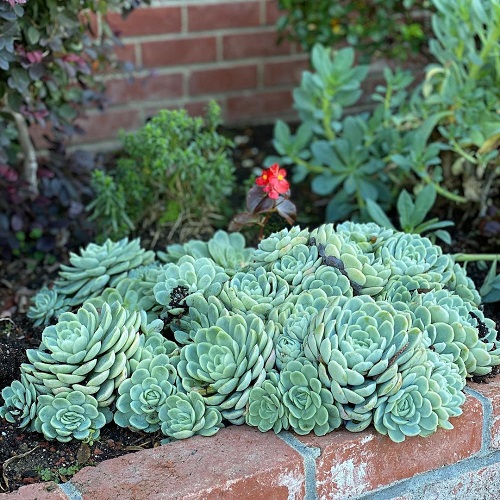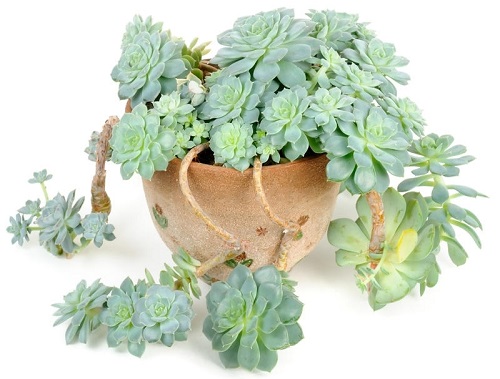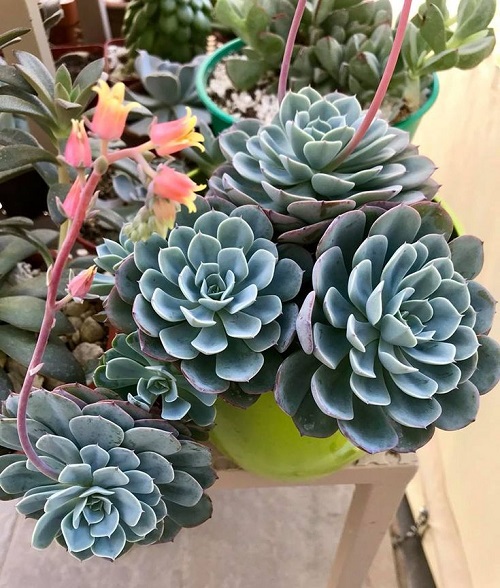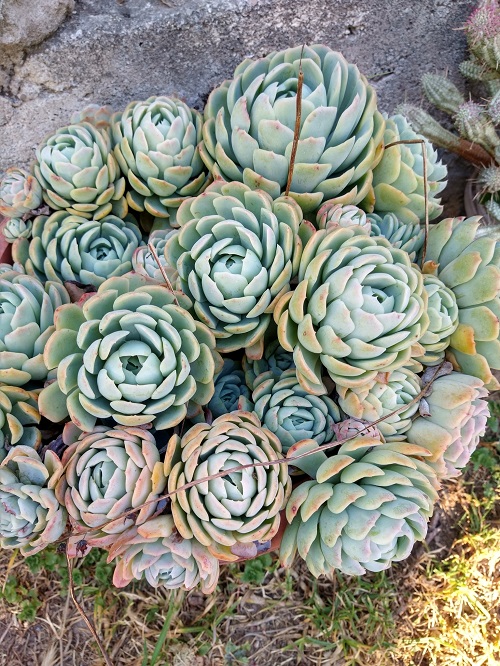Read this detailed article on How to Grow and Care for Echeveria elegans and include this low-maintenance succulent in your home and garden!
Do you want a succulent that is easy to grow and looks good in your plant collection? If yes, growing Echeveria elegant is the best idea for you.
Have a look at the best Echeveria Varieties that Grow Bigger and Fuller here
Echeveria elegans Information
Native to Mexico, Echeveria elegant is commonly known as the Mexican Snowball or White Mexican Rose. The compact size, ease of growing, and adaptability make it an ideal choice for beginner gardeners.
It showcases compact rosettes of fleshy spoon-shaped pale blue-green foliage. Echeveria elegans look beautiful as a ground cover in contemporary rock and desert gardens. In the right growing conditions, this succulent also offers red-pink flowers tipped with yellow from late winter to mid-summer.
Have a look at the best flowering succulents here
Forms and Hybrids of Echeveria elegans
Echeveria comes in many shapes and colors; these species have nearly 150 types which makes it hard for you to select the best one. The forms and hybrids of Echeveria elegans are as follows;
Echeveria albicans
Commonly known as Whitening Echeveria (Echeveria elegans Rose), this clump-forming succulent shows off silver-white rosettes.
Echeveria ‘Gilva’
This cultivar is a hybrid between Echeveria elegans and Echeveria agavoides. It forms a strong, compact rosette with yellow-green leaves.
Echeveria ‘Apus’
This hybrid was developed by Gert Ubink by crossing an unidentified Echeveria pulidonis cultivar with an unidentified Echeveria elegans variety in the year 2006 in Kudelstaart, Netherlands.
Echeveria ‘Hercules’
‘Hercules’ is another patented hybrid created by Gert Ubink by crossing an unidentified Echeveria pulidonis cultivar with an unidentified Echeveria elegans variety in the year 2006 in Kudelstaart, Netherlands.
Echeveria ‘Violet Queen’
This Echeveria elegans hybrid was created by Santa Barbara horticulturist Edward Orpet. It forms a rosette of narrow leaves in a lotus flower shape.
xSedeveria ‘Blue Lotus’
‘Blue Lotus’ is an intergeneric hybrid, a cross between Echeveria elegans and Sedum suaveolens. It displays a rosette of fleshy blue-green leaves.
Echeveria Elegans Propagation

This self-propagating succulent produces new offsets around the base of the mother plant. These new offsets will form a tidy cluster and continue to spread in a container or outdoors in a warm climate and create a dense mat of living carpet.
The new offsets are easy to transplant–just pick them out of the soil and plant them in containers or directly in your desert or rock garden. Additionally, this succulent can be propagated by taking a stem cutting or an intact leaf after healing the part for 3-4 days before planting.
To learn how to propagate succulents–click here
Pot Size for Echeveria Elegans
You should start your new echeveria plant in a small 4 to 6 inches pot and gradually increase the planter size. Because succulent roots are small and shallow, the big pot can house more volume of soil, which can cause a constantly moist growing medium. Also, echeveria elegans grows best when it is pot-bound.
Requirements for Growing Echeveria elegans
Location
All echeverias prefer a location with bright light. Select a spot with partial sunlight with shade in the afternoon; if growing indoors, keeping these on a sunny windowsill would be the best.
If you live in a warm frost-free area, USDA Zones 10 and 11, it is a must to keep the plant safe from the harsh afternoon sun.
When these succulents are being grown outdoors in USDA growing zones lower than 8, it’s best to grow them in containers to bring them indoors to overwinter.
Soil
Grow echeveria elegans in well-draining soil. You can buy potting soil specifically formulated for cacti. Or you can also use a DIY soil mix that is created from an all-purpose potting mix, coarse sand, and/or aquarium gravel; the homemade recipes are listed here.
When planting Echeveria directly into soil outdoors, unless the soil is naturally loamy or sandy, incorporate coarse sand into the soil to enhance drainage. Usually, sloppy and raised areas are best for planting succulent plants.
Here are the best soil recipes for succulents here
Water
Saturate deeply enough so that the water starts to run out of the drainage holes, then wait–before watering again. Wait for the soil to dry fully before moistening the soil again. Remember, echeverias are highly sensitive to overwatering, and doing this can cause leaf drop, root rot and make it prone to pest problems.
The best way is to use a moisture meter to water your echeveria elegans perfectly!
One more important point to remember when it aspect of Echeveria elegans care is to ensure the pot has plenty of drainage holes in the bottom.
Echeveria elegans Care
Fertilizer
Fertilizing is not necessary but can be used to encourage faster and larger growth. Only fertilize during the growing season using a balanced liquid feed, diluted to 1/4 of its actual recommended strength by the manufacturer, once in 10 to 20 days.
The frequency depends on the growing condition you’re providing. If you’re keeping your echeveria elegans in an ideal location, feed it once in 10 to 14 days intervals. If you’re growing it in complete shade, fertilize less often.
Re-potting
Re-potting is not something that has to be done very often, but every couple of years or when the Echeveria elegans may outgrow its container, and you see the mother plant surrounded by pups.
When you re-pot, either remove the mother plant or transfer the pups (new plants) from the old container. And always use fresh soil to fill the container after repotting.
Warm and dry weather, especially the spring or the beginning of the active growing season, like early summer, is the best time to repot: avoid doing this when the weather is harsh–cold, extremely hot, or wet!
Pests and Diseases
Pests don’t often affect echeverias much, but stressful succulents are sensitive to mealy bugs and spider mites. Use insecticidal soap to get rid of these pest infestations, or just wipe them off using a soft wet cloth.
Overwatering or damp conditions cause rot; when tissues rot, they become brown, red, or black and turn soggy, and the plant withers, so take care of that. Remember, when it comes to succulents, watering less frequently is better than doing it again and again.
For treating root rot, take out the plant from its pot, remove the soil, cut the rotting parts and allow the plant to stay in a shaded, warm, and dry place for 3-4 days, and re-pot it in a new pot using fresh dry soil. If you’re using the old pot again, make sure to disinfect it properly.




